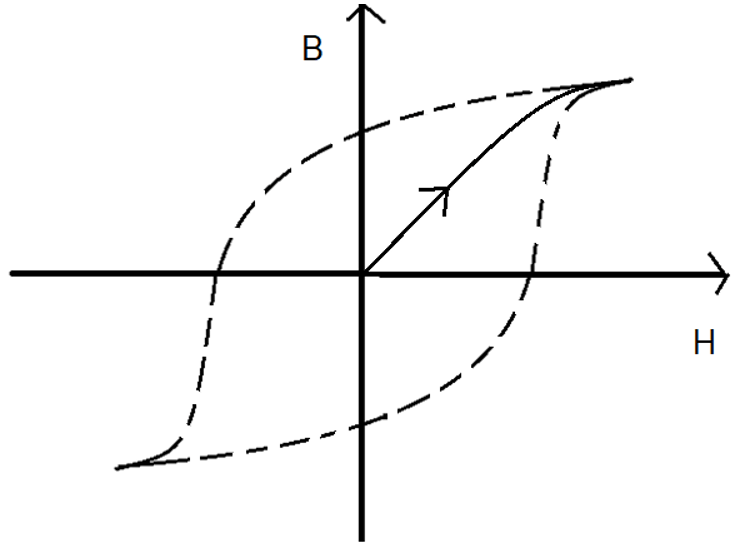This set of Engineering Physics Multiple Choice Questions & Answers (MCQs) focuses on “Classification of Magnetic Materials – 2”.
1. If a material is ferromagnetic, what shall be the value of χ?
a) Negative
b) Small and positive
c) Large and Positive
d) Insufficient information
View Answer
Explanation: When a material is ferromagnetic, the magnetic susceptibility, χ, is large and positive. For a diamagnetic material it is negative and for a paramagnetic material, it is small and positive.
2. Which of the following is a diamagnetic material?
a) Sodium
b) Calcium
c) Oxygen (at STP)
d) Nitrogen (at STP)
View Answer
Explanation: Nitrogen (at STP) is a diamagnetic material. Sodium, Calcium and Oxygen (at STP) are paramagnetic in nature.
3. Which of the following is the correct expression for Curie’s law?
a) χ = Cμ0T
b) χ = Cμ0/T
c) μ0 = C χ T
d) μ0 = C χ /T
View Answer
Explanation: The expression, χ = Cμ0/T, is the correct expression for the Curie’s law. It shows that, for a paramagnetic material, both χ and μ depend not only on the material, but also on the sample temperature.
4. Curie’s law is applicable at every point on a Paramagnetic Material.
a) True
b) False
View Answer
Explanation: As the field is increased or the temperature is lowered, the magnetization increases until it reaches the saturation value, at which point all the dipoles are perfectly aligned with the field. Beyond this, Curie’s law is no longer valid.
5. The phenomenon of perfect diamagnetism is called ___________
a) Superconductivity
b) Diamagnetic Effect
c) Zero Kelvin Effect
d) Meissner Effect
View Answer
Explanation: The phenomenon of perfect diamagnetism in superconductors is called the Meissner effect, after the name of its discoverer. It is used to magnetically levitate superfast trains.
6. Materials in which magnetization persists even after the field has been removed are called ___________
a) Diamagnetic
b) Paramagnetic
c) Soft Ferro magnets
d) Hard Ferro magnets
View Answer
Explanation: In Hard Ferro magnets, even after the magnetic field has been removed, the magnetization persists. Alnico is one such material.
7. Superconductors are diamagnetic materials.
a) True
b) False
View Answer
Explanation: Diamagnetic materials cooled to very low temperatures exhibits both perfect conductivity and perfect diamagnetism. Here the field lines are completely expelled. They are called superconductors.
8. Which of the following is not a constituent of Alnico?
a) Iron
b) Aluminum
c) Magnesium
d) Copper
View Answer
Explanation: Alnico is a hard Ferro magnet. The magnetization in it persists even after the field has been removed. It consists of iron, aluminum, cobalt, nickel and copper.
9. At high temperature a Ferro magnet becomes __________
a) Diamagnetic
b) Paramagnetic
c) Hard Ferro magnet
d) Soft Ferro Magnet
View Answer
Explanation: The properties of a Ferro-magnet are depended on temperature. When they are heated up to a high temperature, it loses its Ferro magnetic properties and become a paramagnet. This transition occurs at a specific temperature, called the transition point.
10. Which material is shown in the figure?

a) Diamagnetic Material
b) Paramagnetic Material
c) Ferromagnetic Material
d) Non-Magnetic Material
View Answer
Explanation: The material shown in the figure is a paramagnetic material. Paramagnetic materials have a tendency to move from a region of weak magnetic field to strong magnetic field, i.e., they get weakly attracted to a magnet.
11. The value of B at H=0 in a Hysteresis curve is called ___________
a) Remanence
b) Coercivity
c) Magnetization
d) Porosity
View Answer
Explanation: The value of B at H = 0 is called the retentivity or the remanence of the material. It shows the capability of a material to hold the magnetization.
12. When a ferromagnetic rod is placed in a solenoid with current, what happens to the rod?
a) Retentivity increases
b) Coercivity Increases
c) Permanently Magnetized
d) Nothing
View Answer
Explanation: When a ferromagnetic material is placed inside a solenoid and a current is passed, the magnetic field of the solenoid magnetizes the rod and it becomes a permanent magnet.
13. What does the following curve show?

a) Magnetization curve
b) Hysteresis curve
c) Polarizing curve
d) Coercive Curve
View Answer
Explanation: The given figure is the diagram of a hysteresis curve. It shows that for a given value of H, B is not unique but depends on the previous history of the sample. This phenomenon is called hysteresis.
14. If the number of atoms in the domain in ferromagnetic iron, in the form of a cube of side length 1μm, is 8.65 X 1010 atoms and dipole moment of each iron atom is 9.27 X 10-24 Am2, what is the maximum Magnetization of the domain?
a) 6 X 105 A/m
b) 7 X 105 A/m
c) 8 X 105 A/m
d) 9 X 105 A/m
View Answer
Explanation: Now, we know the maximum dipole moment = N X m
Mmax = 8.65 X 1010 X 9.27 X 10-24
= 8 X 10-13 Am2
Volume = (10-6)3 = 10-18 m3
Therefore, Magnetization = Mmax/ Volume
= 8 X 10-13 Am2/10-18 m3
= 8 X 105 A/m.
15. Which of the following conditions are desired in the core of an electromagnet?
a) High permeability and High retentivity
b) Low permeability and High retentivity
c) High permeability and Low retentivity
d) Low permeability and Low retentivity
View Answer
Explanation: Ferromagnetic materials have high permeability and low retentivity. Due to these properties, the core of electromagnets is made up of ferromagnetic materials.
Sanfoundry Global Education & Learning Series – Engineering Physics.
To practice all areas of Engineering Physics, here is complete set of 1000+ Multiple Choice Questions and Answers.
If you find a mistake in question / option / answer, kindly take a screenshot and email to [email protected]
